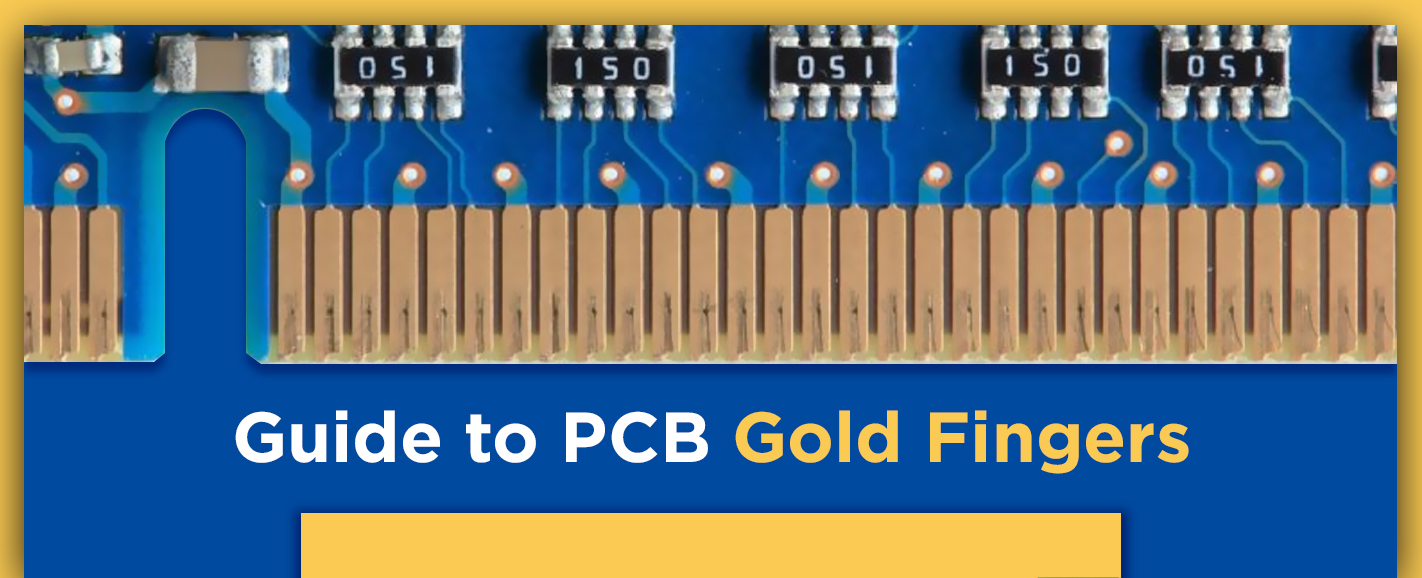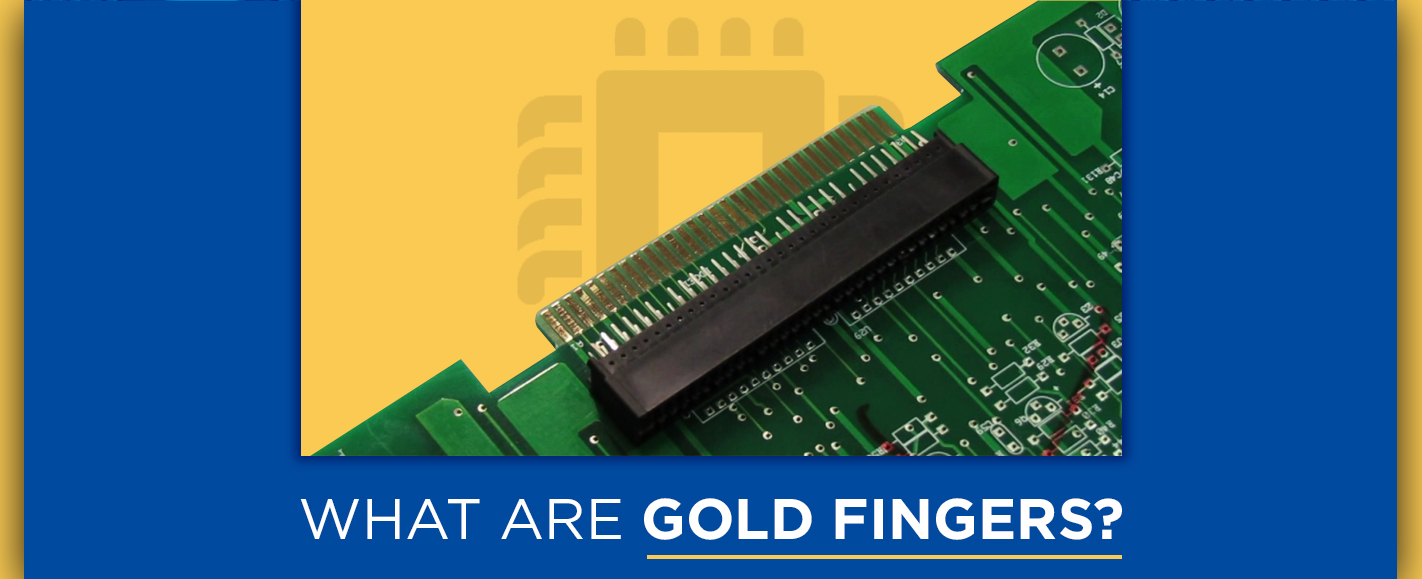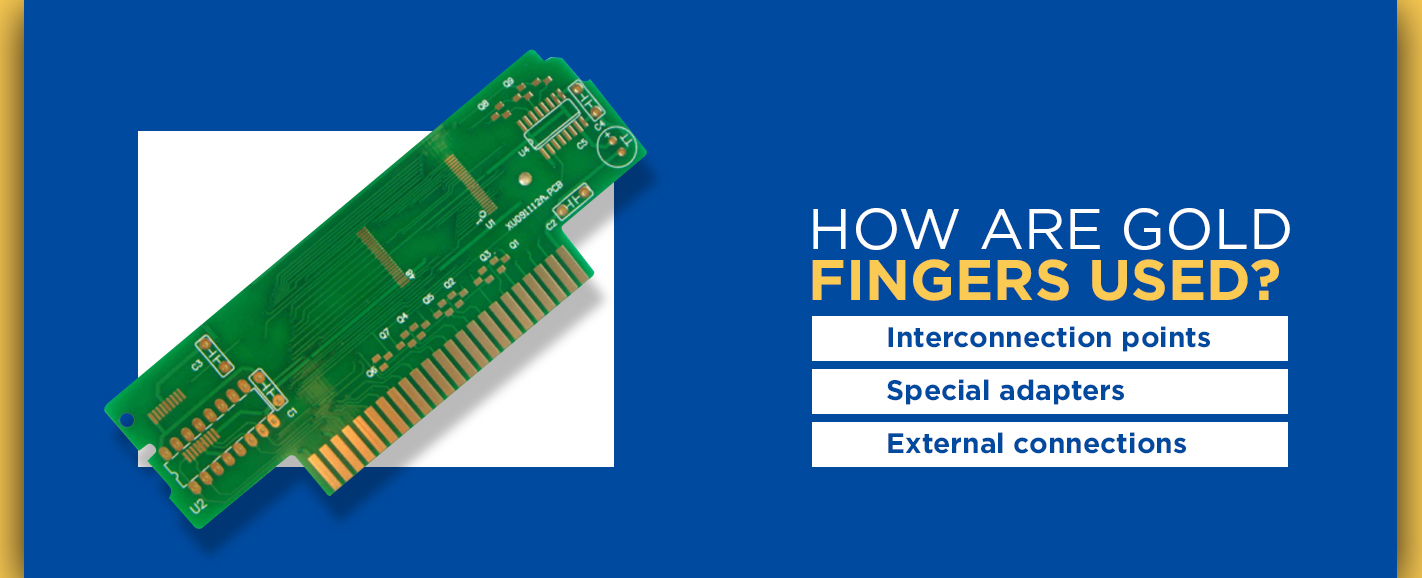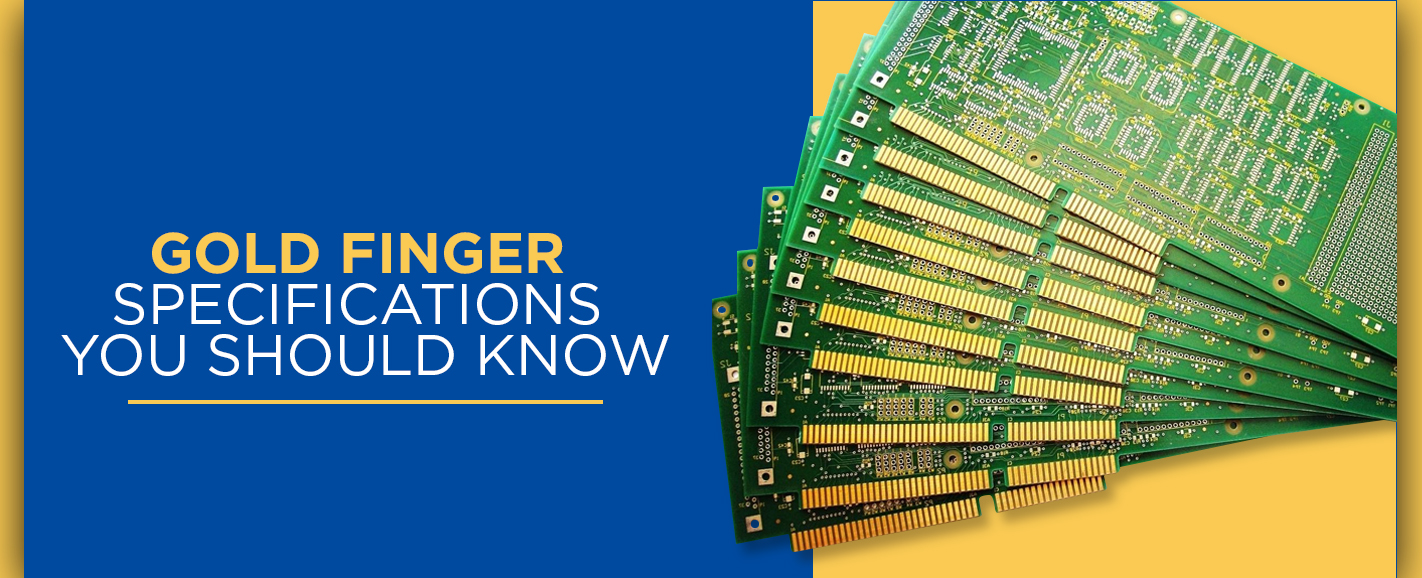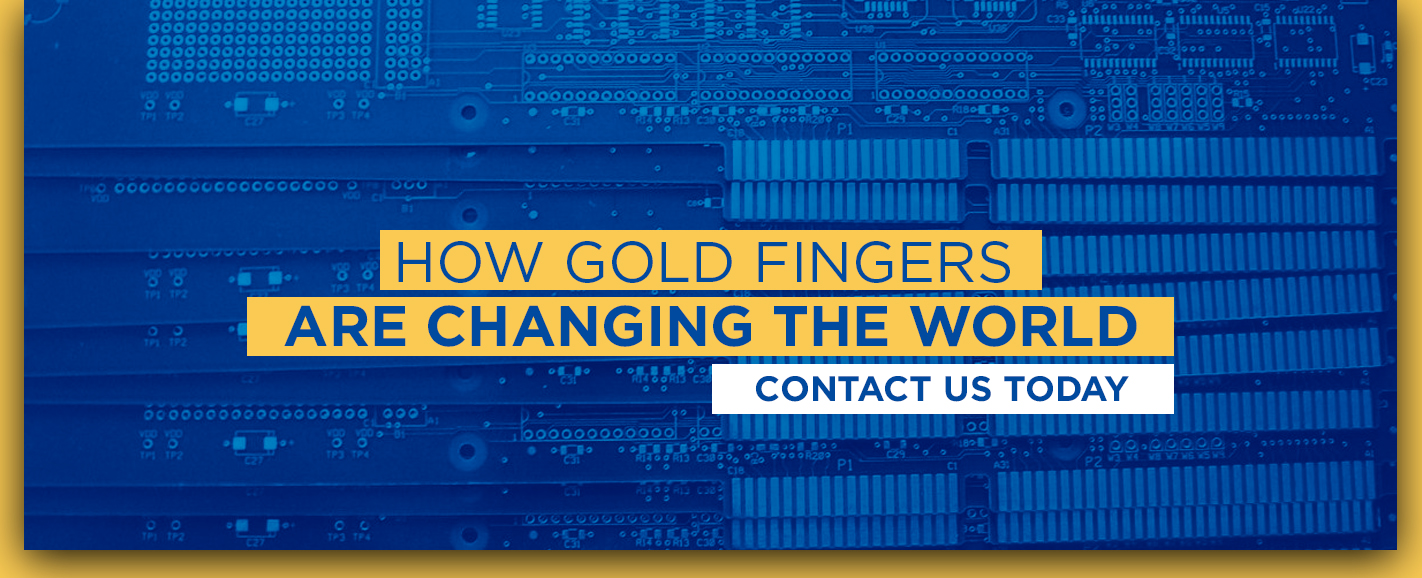Jump To:
- What Are Gold Fingers
- How Are Gold Fingers Used
- Gold Finger Specifications You Should Know
- PCB Gold Finger Beveling
- How Gold Fingers Are Changing the World
In today’s computerized and mobile-activated world, signals are sent between numerous devices. For each command to be enacted, communication must be made between two or more circuit boards. None of this would be possible without gold fingers, which serve as the connecting contacts between motherboards and components like graphics or sound cards.
The technology used to transmit these signals and commands is a huge leap forward from earlier electronics, which typically consisted of separate modules that were difficult to bring into communication with one another. With gold fingers, the processes of one circuit board are immediately read by the main processing board.
The processes associated with this advanced technology extend across all corners of the public and private sectors. In the world of manufacturing, signals are sent between various devices and machines to enact a series of processes, many of which could not be carried out by human hands. At auto-assembly factories and food-packaging plants, numerous commands are fulfilled by computer-prompted machinery, most of which use circuit boards of one size or another.
Many of today’s industrial processes are made possible by gold fingers. So what are they and why are they so important to the inner-workings of computer technology?
What Are Gold Fingers?
Gold fingers are the gold-plated columns that you see along the connecting edges of printed circuit boards (PCBs). The purpose of gold fingers is to connect a secondary PCB to the motherboard of a computer. PCB gold fingers are also used in various other devices that communicate via digital signals, such as consumer smartphones and smartwatches. Gold is used for the connecting points along a PCB because of the alloy’s superior conductivity.
There are two types of gold applicable to the PCB gold finger plating process:
- Electroless Nickel Immersion Gold (ENIG): This gold is more cost-effective and easier to solder than electroplated gold, but its soft, thin (typically 2-5u” composition renders ENIG unsuitable for the abrasive effects of circuit board insertion and removal.
- Electroplated Hard gold: This gold is solid (hard) and thick (typically 30u”), thus more ideal for the abrasive effects of constant PCB usage.
Gold fingers make it possible for different circuit boards to communicate with one another. From the power source to the device or equipment, signals must pass between several contacts for a given command to be enacted.
Once you press a command, the signal will pass between one or more circuit boards before it is read. For example, if you press a remote command on a mobile device, the signal will be sent from the PCB-enabled device in your hand to the near or distant machine, which in turn receives the signal with its own circuit board.
The process involved in the plating of gold fingers involves a number of meticulous steps. This ensures each circuit board rolling off the production line is properly equipped to conduct signals free of error. The standards involved in the plating process also helps to ensure a perfect fit between the gold fingers on each circuit board with the corresponding slots on a given motherboard.
To ensure that all of these fingers and slots fit hand-in-glove, each PCB must pass a series of inspections and defect tests. If the gold plating on a circuit board lacks smoothness or does not adequately adhere to the surface, the results will not be sufficient for commercial release.
For PCB gold fingers to come together, the plating process must be carried out in steps where the surrounding details of the board are completed first. When the time comes to plate the fingers, nickel is applied over the copper. Then, the surface finish is applied last. Once everything has set, the board is inspected under a magnifying lens and subjected to adhesion tests.
How Are Gold Fingers Used?
Gold fingers are used as connecting contacts between two adjoining PCBs. Aside from its conductivity, the purpose of the gold is to protect the connecting edges from wear over many uses. Due to the strength of hard gold at its specified thickness, gold fingers make it possible for a PCB to be connected, disconnected and reconnected up to 1,000 different times in a corresponding slot.
The functions of gold fingers are multi-purpose. With any given computer setup, you will see a number of peripherals that connect with the computer itself thanks to PCB gold fingers. Some of the most widespread uses of gold fingers include the following:
- Interconnection points: When a secondary PCB connects to the main motherboard, it is done through one of several female slots, such as a PCI, ISA or AGP slot. Through these slots, the gold fingers conduct signals between a peripheral device or an internal card and the computer itself.
- Special adapters: Gold fingers make it possible to add numerous performance enhancements to a personal computer. Through secondary PCBs that slot perpendicular into the motherboard, a computer can deliver enhanced graphics and hi-fidelity sound. Since these cards are seldom unattached and reattached, the gold fingers generally outlast the card itself.
- External connections: The outer peripherals that have been added to a computer station are connected to the motherboard with PCB gold fingers. Devices such as speakers, subwoofers, scanners, printers and monitors are all plugged into specific slots behind the computer tower. These slots, in turn, attach to PCBs that connect to the motherboard.
For the corresponding device to work, its own card must connect to a power source. The fingers and corresponding slots on the motherboard make it all possible. Gold fingers provide module PCBs the power to operate and deliver modern-day functionality to users of remote and stationary computing devices.
The flexibility of the PCB system, whereby different slots connect different types of cards, makes it possible to upgrade the same computer periodically over five or ten years. Every time a sound or graphics card is updated, you can remove the pre-existing card from your motherboard and replace it with the new and improved model. Through each update, the PCB gold fingers remain the universal connecting contact.
Beyond the realm of personal computers, PBC gold fingers are also used as connecting contacts in computerized industrial machinery. The large arsenals of mechanized equipment that you would see at a pressing plant or automotive factory will include an assortment of internal cards that connect to a main source of power via gold fingers. Factory robot arms, for example, are powered with gold finger cards that prompt an assortment of movements.
Gold Finger Specifications You Should Know
During the PCB gold finger plating process, certain standards must be adhered to for the fingers to function correctly. The design of the PCB itself must also account for the areas needed for proper finger length and alignment. Regardless of the purpose or size of the PCB itself, the following rules are always applicable in the design of gold fingers:
- Plated through-holes should never be located close to the gold fingers.
- Gold fingers should not have any contact with solder mask or screen printing, both of which should be kept at a distance.
- Gold fingers must always face the opposite direction from the middle of the PCB (if you want the edge to be beveled)
If any of these rules are not followed during the PCB gold finger plating process, the PCB might be incapable of communicating with the parent circuit board. Alternately, the PCB might not fit properly into the appropriate slot on a motherboard.
The reason why gold is used for the connecting fingers on PCBs is due to the alloy’s superior strength and conductivity. The strength of gold makes it possible for the fingers to be inserted and ejected hundreds of times without wear to the connecting contacts. Without the protection of the gold plating, a circuit board could easily be stripped of its connecting functions after a few uses.
You might wonder why gold over other types of metal. After all, gold is one of the rarest and most expensive natural elements. Might it be more cost-effective to plate the connecting edges of PCBs with copper or nickel? Gold, however, is necessary for the functions required of a printed circuit board.
As PCBs were developed into their modern-day form, gold was identified as the most suitable connecting-contact metal on account of several factors. The main benefits of gold are the alloy’s electrical conductivity and resistance to corrosion. For added strength, the gold used in printed circuit boards is usually alloyed in combination with nickel or cobalt, which lend the gold further resistance to wear in the face of constant PCB activity. For the plating process, the nickel has a thickness of between 150 and 200 microinches.
The production standards for PCB gold fingers were established in 2002 by the Association Connecting Electronics Industries (IPC). The standards were amended in 2012 with the release of IPC-4556. In 2015, the standards were again amended with the release of IPC A-600 and IPC-6010, which are currently the most widely employed standards in PCB production. The IPC standards can be summarized as follows:
- Chemical composition: For maximum rigidity along the edges of PCB contacts, the gold plating should consist of between 5 and 10 percent cobalt.
- Thickness: The plating thickness of gold fingers should always fall within the range of 2 to 50 microinches. The standard thicknesses by size are 0.031 inches, 0.062 inches, 0.093 inches and 0.125 inches. The lower thicknesses are generally used for prototypes while the higher thicknesses are used along connecting edges that are regularly inserted, unplugged and reinserted.
- Visual test: Gold fingers should pass a visual test conducted with a magnifying lens. The edges should have a smooth, clean surface and be free of excess plating or the appearance of nickel.
- Tape test: To test the adhesiveness of the gold plating along with the contacts, the ICP recommends a test whereby a strip of tape is placed along the contact edges. After removing the tape, inspect the strip for traces of plating. If any gold plating is evident on the tape, the plating lacks sufficient adhesiveness along with the contacts.
Numerous other standards exist for the PCB gold finger plating process, and all should be read in full for an in-depth understanding. As technology improves, further standards of testing are commonly introduced to the process, so it is best to check back with the IPC for updates periodically.
PCB Gold Finger Beveling
On a circuit board, the PCB gold finger plating process is used after the solder mask and before the surface finish. The plating process generally consists of the following steps:
- Nickel plating: Between three and six microns of nickel are plated first to the connector edges of the fingers.
- Gold plating: Between one and two microns of hard gold are plated over the nickel. The gold is usually enhanced with cobalt for boosted surface resistance.
- Beveling: The connector edges are beveled at specified angles for easier insertion on corresponding slots. Beveling is typically done at angles of 30 to 45 degrees.
On some circuit boards, certain gold fingers will be longer or shorter than others. For example, a circuit board may have longer fingers at one end. This way, the PCB is easier to insert into a slot, as the end with the longer fingers will snap into place more readily. From there, you simply push the other end of the PCB into place.
There are certain restrictions to the plating process. For example, certain distances are needed between the gold fingers and other parts of the circuit board. Key restrictions include the following:
- Inner layers must be copper-free along the PCB edge to prevent copper exposure during the beveling stage.
- Plated holes, SMD and pads should not be placed within 1.0 millimeters of the gold fingers.
- Plated pads cannot exceed 40 millimeters in length.
- A distance of 0.5 millimeters should exist between the gold fingers and the outline.
Any deviation from the standard spacing requirements around the gold fingers on a printed circuit board could result in a physically weak or dysfunctional card.
How Gold Fingers Are Changing the World
Today’s computer and mobile devices are growing ever-more complex as manufacturers compete to make their products faster and more resourceful. If you build a large computer station and amass a handful of mobile devices, you are liable to have numerous gold-plated circuit boards interacting at the same time. Each time you print out an article or scan a photo to upload to a social media account, signals are sent from peripheral devices to motherboard cards, which receive these signals via PCBs.
Thanks in large part to gold fingers, technology has been able to advance to the modern array of mobile devices that millions now use on a daily basis. Moreover, gold fingers have allowed industries to become more productive and capable than ever before.
As increasing amounts of technology rely on gold fingers, it is crucial to have them plated and tested to the highest standards. Only this way can you ensure maximum performance without fail from the tech products that use circuit boards. At Millennium Circuits Limited, we provide PCBs of the highest quality for customers in a variety of industries. Contact us today for a free quote.


